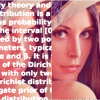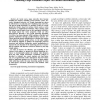194 search results - page 29 / 39 » Reconstructing Randomized Social Networks |
CVPR
2009
IEEE
15 years 2 months ago
2009
IEEE
This paper presents Bayesian edge inference (BEI), a
single-frame super-resolution method explicitly grounded in
Bayesian inference that addresses issues common to existing
meth...
ICASSP
2009
IEEE
14 years 2 months ago
2009
IEEE
— We study the inversion of a random field from pointwise measurements collected by a sensor network. We assume that the field has a sparse representation in a known basis. To ...
KDD
2007
ACM
14 years 8 months ago
2007
ACM
We present a family of algorithms to uncover tribes--groups of individuals who share unusual sequences of affiliations. While much work inferring community structure describes lar...
ICDM
2010
IEEE
13 years 5 months ago
2010
IEEE
In recent years, many networks have become available for analysis, including social networks, sensor networks, biological networks, etc. Graph clustering has shown its effectivenes...
CCR
2010
13 years 7 months ago
2010
In recent years, academic literature has analyzed many attacks on network trace anonymization techniques. These attacks usually correlate external information with anonymized data...


